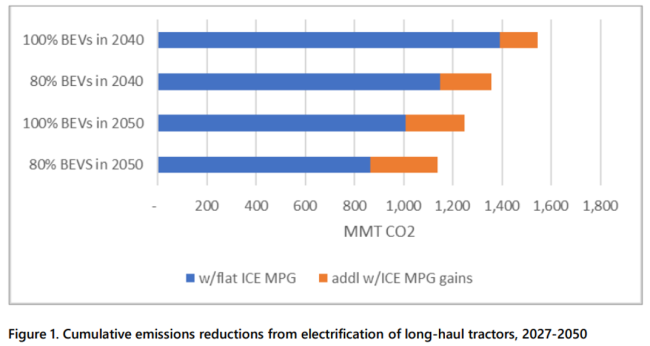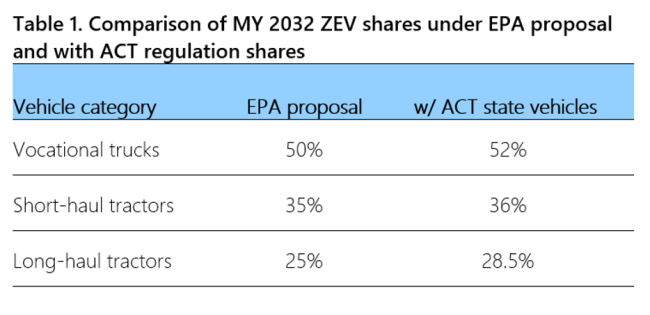Cleaner heavy-duty vehicles are needed for the climate and clean air. Recently proposed emissions rules should require greater improvements for internal combustion engine models and push zero-emissions vehicles to be more efficient to meet national climate goals.
Large vehicles such as trucks, tractors, and buses are a big climate challenge, contributing to more than a quarter of transportation greenhouse gas (GHG) emissions domestically. These vehicles, known as medium- and heavy-duty vehicles (MDVs and HDVs), also spew harmful pollutants that can result in cardiovascular and respiratory diseases and death.
This April, the Environmental Protection Agency (EPA)—tasked with setting GHG emissions standards—released a new set of proposed standards for HDVs. These new standards will cover vehicle model years (MY) 2027–2032. Although billed as the “strongest-ever” standards to date, the proposed rules fall short of maximizing the full potential for emissions reduction in the heavy-duty sector.
What has EPA proposed?
The standards include a new set of targets for MY 2028–2032 HDVs and an update to the previously finalized standards for MY 2027 trucks. EPA’s vehicle technology projections for the proposed standards envision GHG emissions reductions coming primarily from the increasing sales of zero-emissions vehicles (ZEVs). These mostly include battery electric vehicles (BEVs) and, for select applications, fuel cell electric vehicles (FCEVs). After accounting for the emissions from electricity generation, the agency estimates net carbon dioxide reductions of 1.8 billion metric tons between 2027 and 2055 from the proposed rules.
ACEEE identified several areas, though, where the proposed standards miss key opportunities. According to the International Council on Clean Transportation, the proposed standards fail to reduce HDV emissions in line with the Biden administration’s 2030 and 2050 national climate goals. Achieving those goals is an important transitional step to help limit the planet’s warming to 1.5°C.
Standards should require increasing efficiency for internal combustion engine models
While EPA envisions ZEVs being the primary pathway to achieve the standards, their adoption never reaches 100% for any type of HDV, according to EPA’s own projections. In fact, under the proposed standards, more than two-thirds of all MY 2027–2032 HDVs sold will be internal combustion engine vehicles (ICEVs). That means that continuing to improve the efficiency of these vehicles is a must.
The proposed standards ignore the possibility of requiring efficiency improvements for these models, halting progress for these vehicles at MY 2027 levels because they assume that ZEVs alone will be the basis of future HDV emissions reductions. Yet many cost-effective ICEV technologies are available on the market today but remain underutilized. Efficiency improvements such as drag reduction or mass reduction can reduce emissions for both ICEV and ZEVs.
Efficiency improvements are especially important for long-haul vehicles such as sleeper cab tractors that make cross-regional trips. With only 25% of new sleeper cab tractors projected by EPA to be ZEVs in 2032, allowing the remaining 75% of ICEVs to emit at MY 2027 levels would be entirely detrimental to national emissions reduction efforts and the ambient air quality of frontline communities. Figure 1, as an example, shows (in orange) that the total emissions reduction benefit of requiring improved ICEV efficiency for long-haul tractors by 5% each year for MY 2028–2032 almost addresses the gap in emissions reduction from BEVs reaching 80% instead of 100% of the market share in 2040.
Source: ACEEE analysis
Thus, the final standards, known as Phase 3 standards, should require continued HDV efficiency improvement alongside efforts to increase ZEV market penetration to maximize GHG emissions reductions.
The standards should drive ZEV efficiency by accounting for upstream emissions
In the proposal, EPA continues to treat BEVs and hydrogen FCEVs as if they have no climate impact, excluding upstream emissions (such as from the power plants that charge batteries) from vehicle compliance certification values. Yet the upstream emissions from fueling them will be significant during the timespan of Phase 3.
To be clear, ZEVs are generally the far cleaner option and should be encouraged. Yet by excluding upstream emissions from vehicle certification values, the standards do not help reduce these emissions because they are not set to account for them. As a result, manufacturers will not be incentivized to make heavy-duty ZEVs as efficient as possible. Starting MY 2027, the EPA should include upstream emissions in its vehicle compliance values (or gradually phase it in over Phase 3) to maximize the emissions reductions promoted by the standards.
Standards should reflect the full potential for heavy-duty ZEV market adoption
EPA’s proposed emissions standards are based on HDV ZEV adoption rates that only reflect the vehicle’s payback period and its potential to match the capabilities of its ICEV counterpart. The analysis does not reflect the full extent of EV penetration from state actions that independently require zero emissions HDV adoption. These include California’s Advanced Clean Truck (ACT) and Advanced Clean Fuels (ACF) rules, which are much more ambitious. Several states have already adopted the ACT rule. These states constitute 23% of the HDV market.
The EPA should therefore apply ACT-projected ZEV penetration rates for states that adopt the ACT rule before the Phase 3 rules are finalized. Table 1 below shows the impact of applying ACT-projected ZEV market shares for different types of HDVs. Given California’s positive assessment of HDV market costs and competitiveness, EPA can also consider establishing even more ambitious heavy-duty ZEV penetration rates nationwide in setting its final rule targets.
Source: ACEEE analysis
With EV sales shares expected to grow significantly in the coming years, MYs 2027–2032 will be a critical period to speed up the transition to cleaner HDV technologies. By requiring heavy-duty efficiency improvements, including upstream emissions in vehicle certification, and accounting for ACT-driven ZEV adoption, EPA can finalize Phase 3 standards that drive down national GHG emissions at levels possible and necessary.
This post draws from ACEEE’s full comments on EPA’s Phase 3 GHG emissions standards for heavy-duty vehicles.




